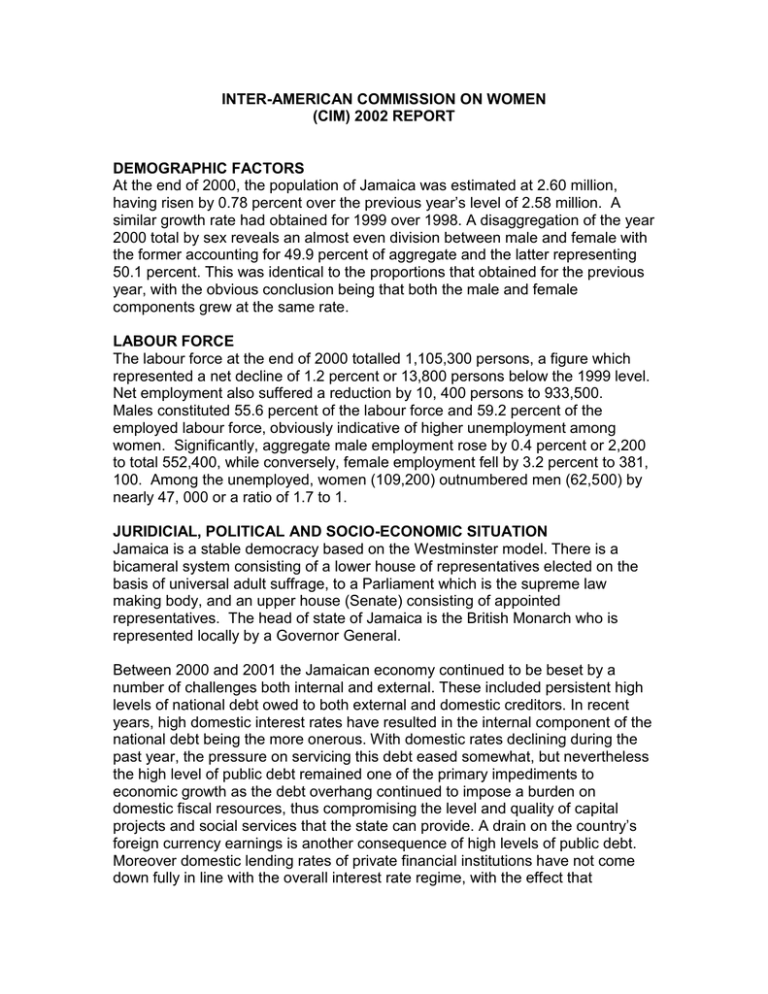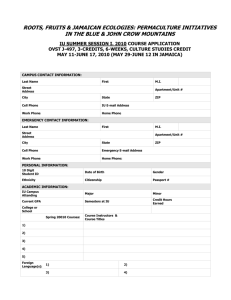INTER-AMERICAN COMMISSION ON WOMEN (CIM) 2002 REPORT DEMOGRAPHIC FACTORS
advertisement

INTER-AMERICAN COMMISSION ON WOMEN (CIM) 2002 REPORT DEMOGRAPHIC FACTORS At the end of 2000, the population of Jamaica was estimated at 2.60 million, having risen by 0.78 percent over the previous year’s level of 2.58 million. A similar growth rate had obtained for 1999 over 1998. A disaggregation of the year 2000 total by sex reveals an almost even division between male and female with the former accounting for 49.9 percent of aggregate and the latter representing 50.1 percent. This was identical to the proportions that obtained for the previous year, with the obvious conclusion being that both the male and female components grew at the same rate. LABOUR FORCE The labour force at the end of 2000 totalled 1,105,300 persons, a figure which represented a net decline of 1.2 percent or 13,800 persons below the 1999 level. Net employment also suffered a reduction by 10, 400 persons to 933,500. Males constituted 55.6 percent of the labour force and 59.2 percent of the employed labour force, obviously indicative of higher unemployment among women. Significantly, aggregate male employment rose by 0.4 percent or 2,200 to total 552,400, while conversely, female employment fell by 3.2 percent to 381, 100. Among the unemployed, women (109,200) outnumbered men (62,500) by nearly 47, 000 or a ratio of 1.7 to 1. JURIDICIAL, POLITICAL AND SOCIO-ECONOMIC SITUATION Jamaica is a stable democracy based on the Westminster model. There is a bicameral system consisting of a lower house of representatives elected on the basis of universal adult suffrage, to a Parliament which is the supreme law making body, and an upper house (Senate) consisting of appointed representatives. The head of state of Jamaica is the British Monarch who is represented locally by a Governor General. Between 2000 and 2001 the Jamaican economy continued to be beset by a number of challenges both internal and external. These included persistent high levels of national debt owed to both external and domestic creditors. In recent years, high domestic interest rates have resulted in the internal component of the national debt being the more onerous. With domestic rates declining during the past year, the pressure on servicing this debt eased somewhat, but nevertheless the high level of public debt remained one of the primary impediments to economic growth as the debt overhang continued to impose a burden on domestic fiscal resources, thus compromising the level and quality of capital projects and social services that the state can provide. A drain on the country’s foreign currency earnings is another consequence of high levels of public debt. Moreover domestic lending rates of private financial institutions have not come down fully in line with the overall interest rate regime, with the effect that 2 business investors still find borrowing for productive purposes to be relatively prohibitive. The financial sector which suffered a shock during the mid to late 1990’s, continued on a path to recovery through state-led stabilization measures. The residual effects on the real sector remain and widespread business failures having contributed to a situation whereby real economic growth in recent years has been at best marginal. The economy has been adversely affected by the September 11, 2001 terrorist attacks on the USA which resulted in a decline in travel. Tourism, the country’s single-most important source of hard currency, has experienced further downturn in fortunes already compromised by domestic budgetary constraints that affected the level of marketing and promotion of the tourism product. In light of all these factors cited above, the high levels of unemployment persisted. The overall unemployment rate for 2000 at 15.5 percent was however marginally below the 15.7 percent rate reported for 1999. A breakdown of the unemployment statistics by sex reveals that male unemployment rose marginally from 10.0 percent to 10.2 percent while conversely female unemployment fell slightly to 22.3 percent from 22.5 percent in 1999. Nevertheless the gap between male and female unemployment remains significant and is therefore a matter of concern. III. MONITORING OF THE IMPLEMENTATION OF THE CIM STRATEGIC PLAN OF ACTION a. The Eradication of Poverty The National Poverty Programme was established in the financial year 1995/96 as a five year multi-sectoral package of activities specifically targeted towards poverty reduction. The objective of the programme is to reduce the number of persons below the poverty line by 50.0 percent in targeted communities, to promote social and economic development and to eradicate absolute poverty in the long term. Within the review period, the Government of Jamaica and the United Nations Development Fund (UNDP) jointly funded a J$24 million project to encourage young, uneducated, unskilled women in Jamaica in the development of income generating enterprises. The project included two inner city communities and one rural community and will provide business support services and related technical assistance to community groups and organizations, to support income generating activities. This programme seeks to build on the foundations of the National Poverty Eradication Programme (NPEP) by strengthening the capacity of communities to make a more meaningful and visible contribution to economic development. 3 The Bureau of Women’s Affairs in seeking to raise the status of Jamaican women, particularly poor and rural women continued to work with community groups. Recognizing that economic empowerment of women is critical for the eradication of poverty, the Bureau engaged in several projects namely: The leasing of land for Potosi Farms in a rural parish to be used to start an agricultural micro-enterprise project for women. The project which carries with it an holistic approach will include community building, group dynamics, and education on issues such as domestic violence, health and family life programmes and sexual and reproductive health. Basket-making project which involves a group of women in another rural community and has resulted in the creation of niche market for their products. In addition, the services of an expert basket-maker from Barbados has been secured to assist the women to improve their skills. b. The Elimination of Violence Against Women and Girls Jamaica continues to grapple with the issue of violence against women and girls. The Centre for Investigation of Sexual Offences and Child Abuse (CISO) reported 2,121 cases of sexual offences in 2000 of which 801 were cleared up. The number of cases represented an increase of 859 more than in 1999. Rape, carnal abuse and indecent assault accounted for most of the sexual offences. Please see Table 1 below on Sexual Offences. Table 1 Sexual Offences 2000 Offences Reported Rape 895 Carnal Abuse 761 Indecent Assault 260 Incest 46 Buggery 57 Assault with Intent to Rape 77 Attempted Rape 23 Gross Indecency 2 Total 2,121 Cleared Up 299 313 90 25 24 36 12 2 801 Source: Economic & Social Survey Jamaica 2002 4 Statistics from the Women’s Crisis Centre which offers services for victims of domestic violence, revealed that from August to December 2000 there were 320 cases of domestic crisis dealt with by the centre. Of this number, 151 were attributed to domestic violence, 51 to rape and 24 to incest. Several initiatives to raise awareness and increase sensitivity on the issue were conducted throughout the review period. The Bureau of Women’s Affairs in its efforts toward gender mainstreaming on issues of violence against women and girls, pursued several programmes and initiatives. Women’s NGOs and other agencies have also contributed to raising awareness and increasing the sensitivity of the public at large to this critical malady. Key sectors included the police, judiciary, the media, teachers’ colleges, schools, churches, communities and places of safety. Programmes to address gender-based violence included: An Inter-Agency Campaign on Violence Against Women, which involved a collaborative approach among several agencies such as the Bureau of Women’s Affairs, Woman Inc. Crisis Centre, SISTREN Theatre Collective, Father’s Inc., and Women’s Media Watch. Funding was received from UN agencies as well as from the Canadian International Development Agency (CIDA) and the Netherlands Government. The campaign focussed on work with the police, conveying the message of domestic violence though dramatic presentations, working with children in places of safety and girls from the Women’s Centre Foundation of Jamaica, sensitising media functionaries, and conducting justice system workshops with lawyers, resident magistrates, clerks of the court, and probation officers. The production of videos by the Bureau of Women’s Affairs with strong messages on incest and domestic violence. These films were shown on one national television station and received wide viewership. Videos have also been made available to be shown in schools, churches and community outreaches. Media - workshops and panel discussions to sensitize media on their responsibility with respect to issues of violence and sex in the media, constituted another aspect towards the elimination of VAW. Legal Reform – Domestic Violence Act, the Incest Punishment Act and the Offences Act to be amended to give 5 more equitable redress. A Sexual Harassment Act is also being proposed. Education & Labour Market Participation In the area of education the trend over the last two years continued to be one whereby females are taking greater advantage of available opportunities. This is manifested in larger numbers of females in educational institutions, particularly at the tertiary level. At the University of the West Indies, data reveal that the gender gap continues to widen in favour of women with only three in ten university students being male. The traditional pattern of male vs. female spheres of employment has remained essentially intact. Interestingly, Jamaica demonstrated a pattern different from that of its regional neighbours in Latin America and the Caribbean, in that females outnumber males in the top occupational groups of Professional (55.3%), Senior Officials and Technicians. However at the boardroom level and in the political directory male dominance remains the norm. Tables 2 below provides an illustration of this trend. Table 2 Leadership of Selected Interest Groups, 1998 Name of Organization No. on Board Men Percent 92.0 No. 3 Women Percent 8.0 Jamaica Manufacturers’ Assn. 37 No. 34 Jamaica Employers Fed. 21 18 86.0 3 14.0 Private Sector Org. of Jamaica 12 11 92.0 1 8.0 Jamaica Agricultural Society 30 26 87.0 4 13.0 Jamaica Exporters Assn. 20 17 85.0 3 15.0 TOTAL 120 106 88.0 14 12.0 Source: Individual Organizations, November 1998 The historical salary differentials in favour of men have yet to be reversed. Participation in Power Structure & Decision-making As was discussed in the preceding section on Education, ironically although women are achieving at higher rates in academia, there are still too few women in position of power and influence at the political and corporate leadership levels. 6 A cursory glance at a number of business firms in Jamaica attests to male control at senior executive levels and the boardroom, evidencing the continued presence of the glass ceiling. See tables 3 and 4. Table 3 Leadership of Selected Special Interest Group Name of Organization Board Men N N Percent Jamaica Manufacturing Assn 35 32 91 Jamaica Employers Federation 19 15 79 PSOJ 12 12 100 Jamaica Agricultural Assn 31 25 81 Jamaica Exporters Assn. 16 13 81 TOTAL 113 97 86 Source: Data provided by the respective organizations, 1998 N 3 4 0 6 3 16 Women Percent 9 21 0 19 19 14 Table 4 Leadership 0f Professional Associations Name of Organization Board N Men Per cent Junior Doctor Association 11 8 73 Institute of Chartered Accountants 17 14 82 Jamaica Bar Association 25 14 56 Medical Assn. of Jamaica 19 14 74 PSAJ 8 6 75 TOTAL 80 56 70 Source: Data provided by the respective organizations. N Women Per cent 3 27 3 18 11 44 5 26 2 25 24 30 N Looking also at women’s leadership role in trade unions, data reveal that on average, men comprise 70.0% of the leadership positions, namely those of president and general secretary. At the political level a similar trend can be observed. Although the President of the Senate and the Speaker of the House are women, there are only two female members of Cabinet, and of a 60 member Parliament, only eight are women (just over 10 percent). See Table 5. Table 5 Participation in Parliament and in Local Government, Jamaica Position Total Men Women Per N Per cent Cent House of Representatives 60 52 87 8 13 Senate 21 16 76 5 24 Cabinet 17 15 88 2 12 TOTAL 98 83 85 15 15 Local Government 227 173 73 54 24 Source: Compiled from 1998 data from the Electoral Office N 7 Health The issue of women’s health continues to be a concern. Poverty, gender based violence, and the limited ability of women to negotiate in their sexual and reproductive lives, all contribute to placing women at greater health risks. The Ministry of Health report that there are distinct gender differences in the incidence of some diseases. For example, there were reports of higher incidences of cardiovascular diseases, respiratory tract infection, diabetes mellitus, hypertension, psychiatric disorders, hypertension and sexually transmitted diseases among women than men. Women accounted for 74.6 percent of the visits for sexually transmitted diseases (STDs). The incidence of HIV/Aids is still far greater than that among women. Of the 5,099 cases reported on AIDS between 1992 to 2000, females accounted for 38.4 percent or 1,974. Among those, of the 3,131 who died from AIDS over the same period 36.8 percent were females. A disturbing factor however is that the rate of increase of HIV/AIDS among women is greater than that for men. The hardest hid age group by AIDS is in the 15-49 age group, when people are in their most productive and reproductive years. Indications also are that adolescent females in the age group 10-19 years are more likely to be infected than any other group. In 2000 the Ministry of Health’s Reproductive Programme focused on family planning, antenatal care and women’s health. The National Family Planning Board took greater responsibility for the screening for cervical cancer through its Health Promotion and Protection Division. A programme to prevent mother to child transmission (MTCT) of HIV was implemented in five parishes. The Government in an effort to deal with the HIV/AIDS epidemic, through its lead agency, Ministry of Health, has developed a Jamaica HIV/AIDS/STI National Strategic Plan 2002-2006. The Plan is based on the analysis of the national HIV/AIDS situation, risk behaviour and factors contributing to vulnerability to the infection. As HIV/AIDS is now being regarded as a developmental issue, the plan has been developed as a national framework in which the work and initiatives of all development partners in Jamaica, including government ministries and agencies, NGOs, CBOs, civil society and donor agencies can be incorporated. The Bureau of Women’s Affairs through collaborative work with the Ministry of Health, the Jamaica Cancer Society and the Southern Regional Health Authority Wellness Clinic also brought health care services and information to women who could not afford these services. One hundred and twenty (120) attended the Wellness Clinic, while one hundred and fifty (150) were screened for breast cancer and three hundred and twenty (320) had pap smears done. 8 b. Description of measures taken to implement the Inter-American Convention on the Prevention, Punishment, and Eradication of Violence against Women, “Convention of Belem do Para” Jamaica has not yet ratified this Convention due to certain reservations. The Convention has been critiqued by the Attorney General’s Department. After careful consideration of the articles of the Convention together with the legislation concerning women, the view is that there are no legal impediments preventing Jamaica’s accession to the Convention. Chapter III of the Constitution together with the Offences Against the Person Act, the Married Women’s Property Act, the Matrimonial Causes Act, the Employment (Equal Pay for Men and Women) act and the common law adequately cover the legal obligations contained in the Convention. The issue that is of concern however relates to the death penalty and the Convention. There is currently a legal debate on whether the Convention prohibits State Parties from imposing a death penalty on a woman. In Jamaica, the right to life is established by section 14 of the Constitution. This right is applicable to both sexes. Section 14 however, qualifies the right by stating that no one shall intentionally be deprived of his life, save in execution of the sentence of a court in respect of a criminal offence of which he has been convicted. The Offences Against the Person is one such statue that provides for a sentence of death to be carried out. Section 3 of the Offences Against the Person Act permits women, who have been convicted of capital murder, to be sentenced to death. The only exception is where women are found to be pregnant, or those who at the time of their conviction are allegedly pregnant. In Jamaica, there has been a long and well-established tradition against the hanging of women and typically, women convicted of the crime of murder have had their sentences commuted to life imprisonment. The last hanging of a woman took place in the 1800’s Article 3 of the Convention states that every woman has the right to be free from Violence. Article 4 states, inter alia, that every woman has the right to have her life respected and not to be subjected to torture. Article 7 places an obligation on State Parties to refrain from engaging in any act or practice of violence against women and to ensure that their authorities, officials, personnel, agents and institutions act in conformity with this obligation. 9 Commissioner Helio Bicudo, a Commissioner of the Inter-American Commission on Human Rights, in a Concurring Opinion dated March 7, 2000, expressed the view that the Convention does not allow the imposition of the death penalty on women. The Attorney General’s Department respectfully disagrees with Mr. Bicudo’s interpretation of sections 3, 4 and 7 of the Convention and the conclusion that he arrived at based on those interpretations. The Department’s interpretation of sections 3, 4, and 7 of the Convention is that it does not prevent State Parties from imposing the death penalty on women. The Department recommends that Jamaica should accede to the Convention. Before accession however, the Government is presently having discussions on whether it wishes to confirm its present policy of imposing life sentences on women convicted of capital murder. This would necessitate an amendment o the Offences of the Person Act. This amendment would remove any doubts as to whether Jamaica is in a position to comply with all the provisions of the Convention. It should be noted however that such an amendment could quite possibly be challenged on the ground of being discriminatory against men. FUTURE ACTIONS TO ADVANCE THE IMPLEMENTATION OF THE CIM STRATEGIC PLAN OF ACTION a. At the national level to improve the status of women It is obvious that women have no legal impediment to participation at all levels of the Jamaican society. What is needed at this point is an effort to remove the attitudes learnt through patriarchy over the centuries. b. At the regional level to support actions promoted by the CIM in the short term. Efforts being made to have more regional cooperative efforts to share best practices and technical skills. Prepared by the Bureau of Women’s Affairs August 30, 2002



